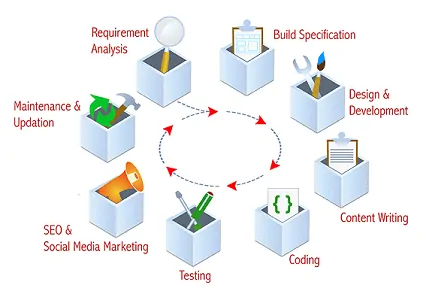In part 1 of Thinking Things Through, I described some of the methodologies I’ve used for software development. When I Google “website development methods,” what I see from multiple companies are variations on one or more of the software development methods. Usually, they look like a typical waterfall process. Snip the circle, straighten the circle into a line, and you have the waterfall process.
There’s something they miss.
These methods give an analyst the tools to derive a requirements document which generates a design which gets implemented in html or through a content management system. In other words, the tools let the developer build their view of what the website should be. That’s not the developer’s job.
The developer’s job is to build the website the client needs. Sometimes that’s not exactly what the client thinks they need, so it’s the developer’s job to help the client see other possibilities. Using sophisticated tools and lifecycle methodologies isolates the developer from the client. That’s not good. It’s too complicated for the client.
Website Development Must Be People-Based
Rather than starting to understand the client’s requirements with pen in hand to draft notes or graphics of processes, etc., it’s better to shut-up and listen.
Understanding Needs
Here are some open-ended questions to get the client to talk about what they need.
-
“What will a good website do for you? Your clients?”
Establish a dialog to explore the goals the client has along with a good understanding of who the business and website serve. -
If there is website being replaced, ask “How has the current website met your needs?”
Build on success before understanding deficiencies and failures. Most likely, you’ll learn of deficiencies too. -
“Tell me about your competitors and their Internet services.”
You want to know who the competitors are so you can evaluate their web presence. -
“How do you see your role in developing and maintaining the website”?
You want to know how they will present content to you for the website. Will you do the data entry? Will you have to re-write content for the web? Will they want to create and edit content on the website?
Start Thinking
Here are some questions for you. Your client may have ideas too. Listen up!
-
How can the website
-
Attract new users?
-
Retain existing users?
-
Guide people toward a desire response?
-
Reduce bounce rate?
-
What content or services are essential?
Assuming that you and your client have a common vision, talk/think through the required content, marketing approach, and expected outcomes of the website. You may discover a need to change some goals, and clarify your client’s role in the developing process. Sometimes clients assume that the developer can develop the website content; that’s the client’s job—always. The developer—you—can edit it, format it, and enhance it with graphics and a pleasing design.
